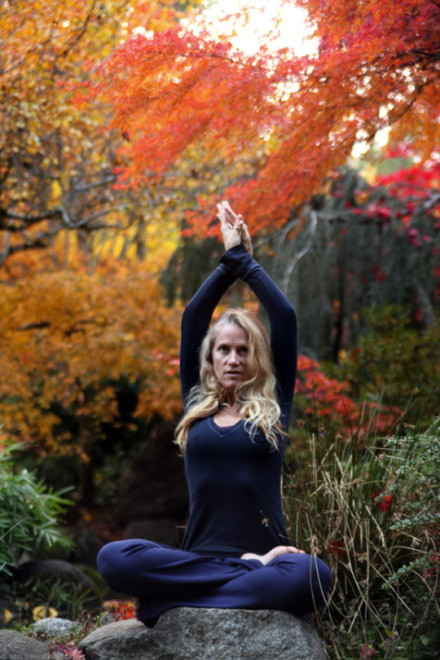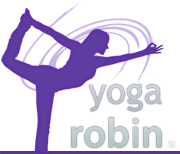Are you more right-brained or left-brained while you practice yoga?
 Sunday, November 4, 2012 at 2:32PM |
Sunday, November 4, 2012 at 2:32PM |  robin
robin Right-brain? Left-brain?
Do you associate more with the right side of your brain while you practice yoga or the left side of your brain?
 The two hemispheres of the brain have fascinating connections (Photo credits: Simeon Schatz)
The two hemispheres of the brain have fascinating connections (Photo credits: Simeon Schatz)
Creative vs. logical
The right-brain/left-brain theory grew out of the work of Roger W. Sperry in the late 1960s, who was awarded the Nobel Prize in 1981. The cerebral cortex controls rational functions and is made up of two halves, connected by masses of nerve fibers which pass messages between each other. These halves, or hemispheres, are commonly referred to as right-brain and left-brain.
The right-brain is best at expressive and creative tasks. Characteristics associated with the right-brain include emotions, music, color, intuition and creativity. The left-brain is considered to be adept at tasks that involve logic, language and analytical thinking.
People are said to prefer one type of thinking over the other. Each of us has the propensity to have a mix between the two, but be more predominant with the left or right side of the brain with certain activities.
Yoga brain
In my opinion, the poses and teachings of yoga allow me to subdue my left-brain, bringing it under control with the training and discipline inherent in yoga. This illuminates my right-brain in ways that seem mind-blowing...
Jill Bolte Taylor, a Harvard Brain scientist, shares this theory. She had a life-changing experience when a stroke in her left-brain shut down most of its functioning, thereby illuminating her right-brain activity and control. She tells her story with hopes to promote peace for those who can utilize ways to allow the euphoria she experienced. So, if we take her stroke of insight and apply it to yoga, we can deduce that the disconnect between euphoric states and reality can be explained by the relationship between the left-brain and right-brain.
In other words, that which divides us is simply the mind...
Looking at the connections between psychological processing and yogic, spiritual experiences, it seems true that in everyday life we have a tendency to let our psychological ego (primarily left-brain) take over our identity in the world. Mindless chatter and formulations of who we are in the world keep us on the ground.
In contrast, a spiritual experience moves us to another realm where time and space do not appear to exist. This focus connects us to the right-brain, disconnected from brain chatter. In the pure right-brain there is peace and a new definition of reality. In these experiences, we may not know (or care) where our bodies and minds begin and where we end. Without all of the stresses of the real world (no left-brain activity), bliss takes over. It's pure submission of the left-brain to the right-brain.
In terms of Sankhya-Yoga, by calming the rajas and tamas I can leave the excessive chattiness or sluggishness of the left-brain to rest. My goal in yoga—samedi—is absent of all detailed left-brain thought when it's dialed in to the spaciousness and spirit that emerges, indicative of the right-brain.
Artistic brain
Let's take another activity to compare. When I start a painting, I first need be able to to visualize the final painting in my mind (right-brain activity), and then develop the painting by doing various tasks simultaneously such as choosing the elements, matching and mixing colors, and placing shadows and highlights (more right-brain). But, at the same time I must be able to look critically at what I'm doing (left-brain activity).
So, our creative juices (right-brain) formulate inventive way to display our dreams in our minds. Yet, when methodically creating structure, edges or following an instruction of some sort, the left-brain kicks in.
Physical activity brain
With a sport such as running, the goal-driven act to go a certain distance and route is left-brained. Allowing adrenalin to become spiritual to take us higher and away from it all is the right-brain in full swing.
Back to yoga and the physical aspects. Using the same philosophy, a rigid routine such as Bikram or Ashtanga Primary Series would fall into the methodical left-brained realm, whereas self-led Vinyasa Flow guided in a moment by the soul or music is right-brained. Yet, with a dedicated yoga practice, before beginning we see the whole first (right-brain) and then let the details take us there. And, Vinyasa Flow can have the propensity to start out without a vision, letting details take us (left-brain).
Spiritual brain, living yoga
I, myself, during my peak moments in life find that what may appear as fear in chaos comes together within me as peaceful when I realize the intricate balances in life. The truth that it all matters—chaos and explanation—thereby points out that to live yoga in everyday life is to balance out the right-brain and left-brain activity. The best place to figure it all out is in my yoga practice.
What has your experience been?
© 2012 Yoga Robin®
 body,
body,  chaos,
chaos,  creativity,
creativity,  emotional health,
emotional health,  left-brain,
left-brain,  living yoga,
living yoga,  mind,
mind,  peace,
peace,  right-brain,
right-brain,  sankhya yoga,
sankhya yoga,  vinyasa flow | in
vinyasa flow | in  ashtanga yoga,
ashtanga yoga,  psychology,
psychology,  spirituality,
spirituality,  yoga
yoga 
Reader Comments (2)
I read your article. It's written very nicely. It's new to me,knowing all these.
Even though I trust the immense power of yoga and pranayam, but I
Would prefer not to do any such type of yoga that interfere with the
Natural creation of our mind, that is we all are creation of the Almighty
And he has made us unique. Anyways I would prefer knowing something
More about right brain and left brain.
I agree with you. My introspection on left and right brain is not indicative of what a normal yoga practitioner goes through. It does not interfere. I like to learn more and write about it later :)